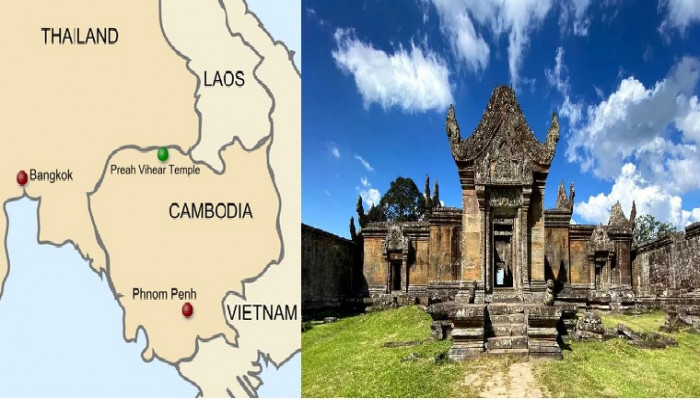Exercising Soft Power: Diplomatic Role of India in the Thailand-Cambodia Conflict
- In Military & Strategic Affairs
- 10:22 PM, Sep 22, 2025
- Khushi Mishra & Dr. A. Adityanjee
History is often told in grand strokes of wars fought, treaties signed, and empires rising and falling. But sometimes, the most profound stories are found in diplomacy's quiet, patient work. For decades, the border conflict between Thailand and Cambodia, particularly over the ancient Preah Vihear temple dedicated to Bhagwan Shiva and surrounding territories, has been a recurring flashpoint in the Southeast Asian region. While global attention has often focused on the more dramatic confrontations, India has played a crucial, though often understated, role in navigating this delicate situation. This is how a civilisational friend became a modern-day anchor for regional stability.
A Legacy of Shared Heritage
To understand India's role, one must first appreciate its deep historical and cultural ties to Thailand and Cambodia. Centuries ago, Indian and Indic-influenced kingdoms flourished in the region, leaving an indelible mark on art, religion, and governance. The magnificent Angkor Wat, the crown jewel of Cambodia, stands as a testament to this shared legacy, a Hindu temple dedicated to Bhagwan Vishnu that later became a Buddhist site. Similarly, Buddhism, which originated in India, is the predominant religion in Thailand, shaping its cultural ethos and societal values.
Established in 1782, the Chakri Dynasty is the current ruling dynasty of Thailand. King Rama I, the founder, moved the capital to Bangkok and initiated significant reforms. This Hindu-Buddhist dynasty has played a crucial role in modernising Thailand and promoting national identity, and preserving culture and heritage. The current monarch, King Maha Vajiralongkorn (King Rama X), ascended the throne in 2016. Thai princess Sirindhorn, fondly called Phra Thep (princess angel), is a renowned educator and scholar of Sanskrit and Pali. She has been a patron of Sanskrit studies in Thailand and the propagation of Sanskrit globally. This profound, ancient connection with Indic culture, philosophy and heritage provides a unique foundation for India's diplomatic engagement, allowing it to approach both nations not as mere geopolitical players but as civilizational partners.
This shared heritage has given India a unique credibility in the region. Unlike other major powers, India is not seen as a rival or a colonial successor. Instead, it is viewed as a source of cultural and spiritual wisdom, a non-interfering force for peace. This perception has been a cornerstone of its "Look East" and now "Act East" policy, which seeks to forge stronger economic, political, and strategic ties with Southeast Asia.
The Heart of the Conflict: A Clash of Histories
The Thailand-Cambodia conflict has its roots in colonial-era maps and historical claims. The most significant point of contention has been the 11th-century Preah Vihear temple, perched atop a cliff overlooking Cambodia. While the International Court of Justice (ICJ) ruled in 1962 that the temple belonged to Cambodia, the exact demarcation of the surrounding border remained ambiguous. In July 2008, the temple complex was declared a World Heritage Site by UNESCO. Thailand opposed it because the territory around the temple was never demarcated between the two countries. This ambiguity, coupled with nationalist sentiments, led to repeated military clashes over the years, causing casualties and displacing thousands.
These skirmishes, while localised, posed a significant threat to regional stability, a reality that concerned both nations' neighbours and global powers. The conflict revealed the limits of traditional diplomatic mechanisms and the enduring power of historical grievances. It was in this environment that India's quiet diplomacy found its purpose.
India's Diplomatic Blueprint: Non-Interference, Strategic Engagement
India's approach has been defined by a principle of constructive engagement without direct interference. Instead of taking sides, India has focused on three key areas: bilateral relations, multilateral forums, and humanitarian assistance.
Bilaterally, India has maintained strong, cordial ties with both Thailand and Cambodia. India has a robust strategic partnership with Thailand, marked by joint military exercises like MAITREE and growing cooperation in maritime security, trade, and cultural exchange. This relationship is a key pillar of India's Indo-Pacific strategy.
At the same time, India's relationship with Cambodia is equally strong, though rooted more in developmental and cultural cooperation. Some suggest that the name "Cambodia" is derived from the Sanskrit word "Kambuja," which was the name of an ancient Hindu-Buddhist kingdom that existed in the region. The term "Kambuja" is believed to have been used to refer to the people who inhabited the area, and over time, it evolved into the name "Cambodia." India has provided significant assistance for capacity-building and heritage conservation, a gesture deeply appreciated by the Cambodians. The restoration work by the Archaeological Survey of India (ASI) at Preah Vihear itself from 1986 to 1993, well before the most recent clashes, is a powerful symbol of this partnership, demonstrating a commitment to preserving shared heritage rather than claiming territory.
Multilaterally, India has leveraged its position within platforms like the ASEAN Regional Forum (ARF) to encourage dialogue and de-escalation. By participating in these forums, India has consistently advocated for a peaceful resolution, emphasising the importance of ASEAN centrality and regional solidarity. This role as a respected, neutral party has given India the space to push for dialogue when tensions were high, helping to prevent the conflict from spiralling out of control.
Recent Developments and India's Role
The conflict saw a significant escalation in mid-2025, bringing the long-standing border dispute to the forefront. Military clashes, which began on May 28, quickly intensified, resulting in dozens of fatalities and the displacement of over 300,000 civilians. The border was sealed, and diplomatic relations were downgraded, with both countries expelling each other's ambassadors. The situation was exacerbated by domestic political tensions, particularly in Thailand, with a leaked phone call between Thai and Cambodian political leaders sparking outrage.
In response to the humanitarian crisis and escalating violence, India's Ministry of External Affairs (MEA) issued a travel advisory for its citizens in the region, urging them to avoid border areas and stay in contact with the Indian embassies in Bangkok and Phnom Penh. This pragmatic step was a clear signal of India's concern for the safety of its nationals while also subtly urging de-escalation by highlighting the risks of continued conflict.
The ASEAN charter mandates renunciation of force and the use of military force in solving bilateral disputes. While the conflict was managed mainly through diplomatic efforts from ASEAN, particularly a Malaysian-hosted truce on July 28, 2025, India's quiet support for these regional mechanisms was crucial. By not taking sides, India maintained its position as a neutral and trusted partner, which can be invaluable in a post-conflict scenario where de-escalation and long-term resolution are needed. The recent agreements between Thailand and Cambodia to withdraw heavy weaponry, clear landmines, and reopen trade routes on September 11, 2025, are a testament to the success of regional diplomacy - a process India has consistently championed.
A Blueprint for the Future
India's diplomatic role in the Thailand-Cambodia conflict is a masterclass in soft power and strategic patience. By building on its historical and cultural ties, India has positioned itself as a credible and non-threatening partner to both nations. Its actions have consistently promoted stability and peace, from providing development aid and cultural preservation support to advocating for dialogue in regional forums.
One of us had highlighted the need for India to make serious efforts to resolve this conflict between two dharmic nations as early as 2011. Efforts should be made to use Dharma principles like peace, harmony and universal brotherhood (Vasudhaiva Kutumbakam) to defuse the situation and avoid further bloodshed. Perhaps, it will make sense to arrange an international Yoga camp near the Preah Vihear Temple in order to defuse the situation on a long-term basis. Under Dharmic leadership and guidance, a proposal for joint sovereignty by these two countries could be considered as one of the possible solutions.
Considering the religious sensitivities involved, only Hindu and Buddhist peace-keeping forces should be deployed to prevent any possible intentional or unintentional desecration of an ancient and revered Hindu Temple by the uninformed outside peacekeepers provided under the banner of the UN.
This regional Dharmic dispute has long-term geopolitical implications. India needs to take proactive steps to maintain and extend its soft power. India should not allow extra-regional hegemons (like the US and China) to insert themselves in this dispute and play big power games to the detriment of the region. India should take a proactive stance and partner with Japan in the mediating and facilitating role as two ancient Asian civilisations.
India’s role as a civilisational power and Vishwamitra is meaningless if we cannot utilise our soft power for the common good of humanity in resolving disputes in our near-abroad region. India should enter as a suave and moderating influence in aiming to resolve this decade-long dispute. Enhancing peace and stability on the Thai-Cambodian border will go a long way in establishing India’s credentials as a benign civilisational power and a friend of the world in the ASEAN region.
Perhaps, as a goodwill gesture, the Government of India and specifically the Archaeological Survey of India (ASI), can take a lead in renovating this Hindu Temple just like the famous Angkor Wat was restored. Perhaps, as a confidence-building measure, the government of India should announce an allocation of $200 million grant immediately for the work on renovation and restoration of the Preah Vihear temple complex and peacekeeping.
We urge India’s diplomatic establishment earnestly to take the leadership mantle on behalf of India to make a historical intervention by announcing a high-profile Prime Ministerial visit to Preah Vihear Temple complex and announce India’s sincere desire to mediate between the two warring but brotherly Dharmic nations. History will always remember India for statesmanship if MEA can use its good offices to permanently defuse this conflict and ensure enduring peace in this region.
Though tragic, the recent outbreak of conflict also underscored India's quiet influence. When the conflict turned deadly, India's immediate response was not to condemn or take a position but to ensure the safety of its people while subtly supporting the regional diplomatic efforts to find a solution.
In a world of increasingly great power competition, India's approach is a powerful reminder that diplomacy rooted in mutual respect and shared values can be a more effective tool for peace than military posturing. As India's "Act East" policy continues to evolve, its enduring commitment to peace and stability will grow more critical, making its quiet hand a powerful force for good in Southeast Asia and beyond. A newly resurgent, self-confident India has an opportunity to go a step further and adopt a more obvious and logical diplomatic posture of “Be the East” policy, identifying fully with the East in contrast to the West.
References
- Adityanjee: India's Soft-Power: Call Comes from the East! Vivekanand International Foundation Feb 18th, 2011, https://www.vifindia.org/article/2011/february/16/India-s-Soft-Power-Call-Comes-From-The-East
- Perea, P. M. (2011). Ghostly I(s)/Eyes: The Formation of Subjectivity in Mexican American Life Narratives.
- Plaster Magazine. (n.d.). "These materials are the truth". Plaster Magazine.
- Ministry of External Affairs Library. (1976-1977). Annual Report 1976-77.
- Duangratana, O. (2022). The dynamics of democratisation and the implications for Thailand's foreign policy.
Disclaimer: The opinions expressed within this article are the personal opinions of the author. MyIndMakers is not responsible for the accuracy, completeness, suitability, or validity of any information on this article. All information is provided on an as-is basis. The information, facts or opinions appearing in the article do not reflect the views of MyindMakers and it does not assume any responsibility or liability for the same.







Comments